Menus

Jahn

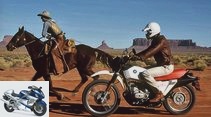
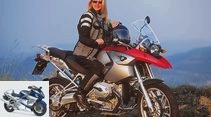
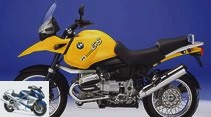
71 photos

BMW
1/71
1985: Little Gaston Rahier fights his way through the desert again with his huge HPN boxer and can successfully defend his title at the Dakar.
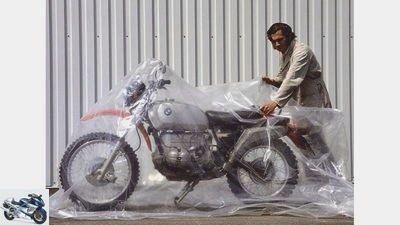
BMW
2/71
1979: The first prototype of the new series is shown.
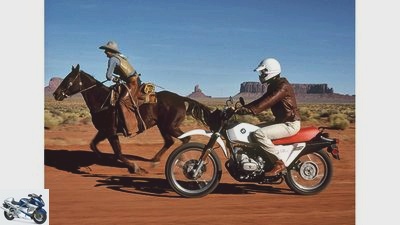
BMW
3/71
A future motorcycle monument in Monument Valley.
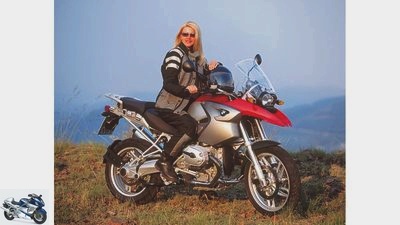
BMW
4/71
A modernized 1200 boxer engine that has been boosted to 100 hp makes its debut. It is significantly lighter, has a balancer shaft and knock control.
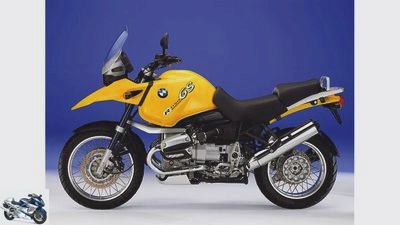
BMW
5/71
R 1150 GS.
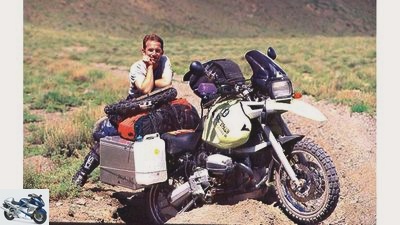
Schroder
6/71
1997: MOTORRAD editor Michael Schroder got stuck with the R 1100 GS in the Gobi desert due to clutch damage. His bike was stolen and found in a battered state a year later.

BMW
7/71
1984: World champion in motocross, now hero at the Dakar: Gaston Rahier wins on a 75 hp 1000cc. BMW silvered the rally success with the special model R 80 G / S ?? Paris-Dakar ??.
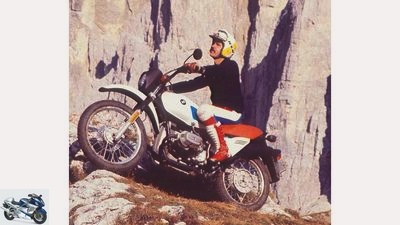
BMW
8/71
What a success!

9/71
1994: With four valves and injection, the GS series with 850 and 1100 cubic capacity started technically into the modern era in 1994.

BMW
10/71
R 80 G / S in off-road use.
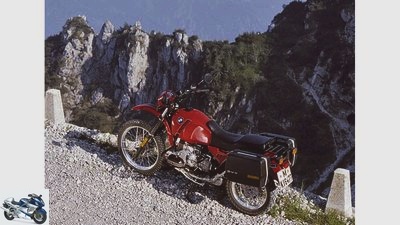
BMW
11/71
1988: R 80 GS.
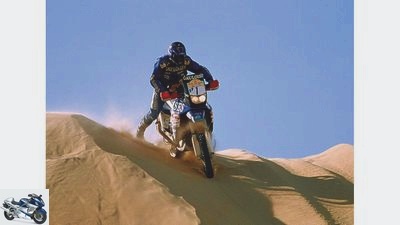
BMW
12/71
2000: a great result ?? BMW took the first four places at the Dakar, three of them with the single-cylinder F 650, including winner Richard Sainct. The American Jimmy Lewis finished third with his HPN-tuned R 900 RR.
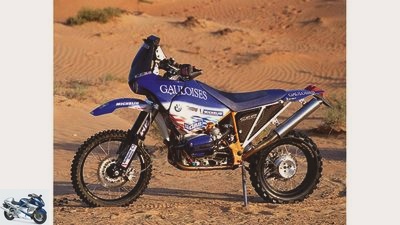
BMW
13/71
Factory racer R 1150 GS / RR at the Dakar Rally 2000.
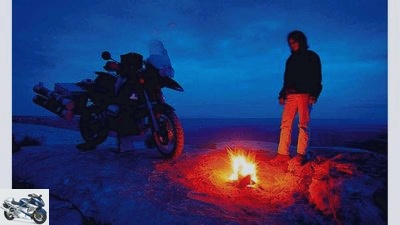
Martin
14/71
1999: Michael Martin and his girlfriend start an ambitious project: across all the deserts of this earth. His means of transport: a fully packed BMW R 1150 GS ?? what else?
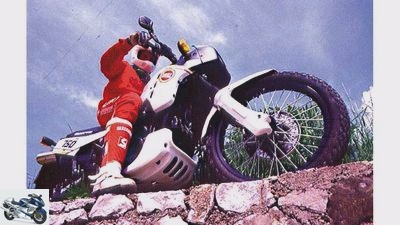
15/71
1985: The Italians are also involved in rallying and bring the Cagiva 650 Elefant, which costs 12,390 marks. Five hundred marks more expensive
as a BMW, with a cultivated Ducati engine, from 1987 as a 750.
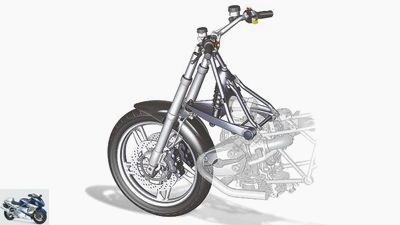
Drawing: BMW
16/71
The Telelever is a synthesis of swingarm and telescopic fork – fork legs without damper elements, but with a central spring strut on the wishbone.
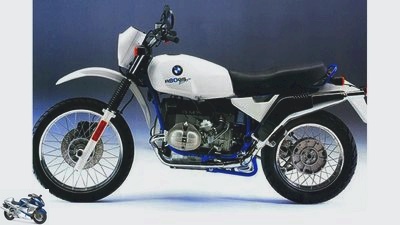
BMW
17/71
The 800? Basic ?? (until 1997) was the last two-valve GS.
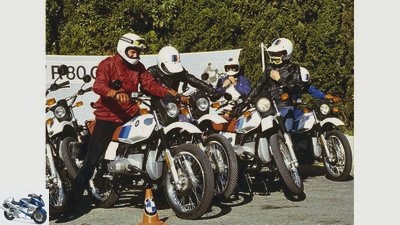
BMW
18/71
1980: The development team needed only one year and nine months from the start of the project to the official press presentation of the R 80 G / S on September 1, 1980 in Avignon, France.

BMW
19/71
1989: special model "Paris-Dakar" the R 100 GS.
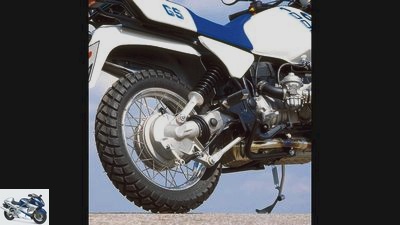
BMW
20/71
BMW is further developing the characteristic cardan drive. The patented Paralever rear swing arm of the new R 80/100 GS generation reduces load change reactions.

Yamaha
21/71
1989: Yamaha, trendsetter in the enduro sector, slept through the two-cylinder segment. The 69 hp Yamaha XTZ 750 Super Tenere does nothing to change that, and it soon disappears into oblivion.
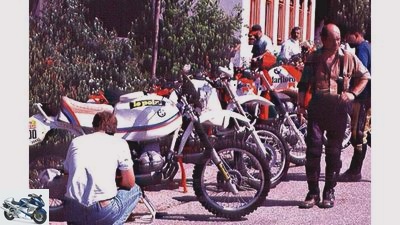
Johann
22/71
2000: 270 GS riders come to the MOTORRAD meeting on the occasion of the GS’s 20th anniversary: to celebrate, chat and be amazed ?? about the machine of the Paris-Dakar winner of 1981/83, Hubert Auriol.
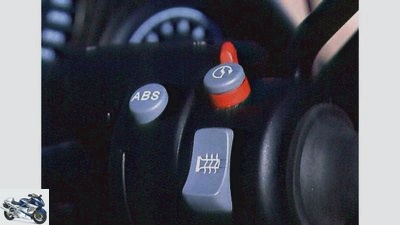
Gargolov
23/71
2003 ABS is optional equipment for the R 1150 GS, and almost every buyer in Germany orders it. Now a new ABS variant, the integral ABS with electric brake booster, is replacing the previous ABS II.

BMW
24/71
1979: After a decade of restraint, BMW returns to off-road racing with a works team and wins the German championship with Richard Schalber in 1979.
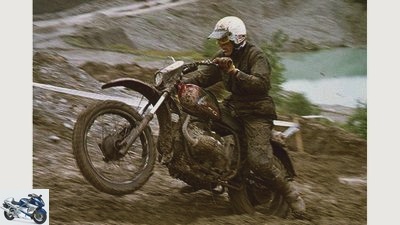
25/71
Sports forerunner: Factory enduros took part in international races as early as the 1960s and 1970s. In the picture: Herbert Schek at the Enduro European Championship 1978.

26/71
1999: Technically based on the 1100, the R 1150 GS with 85 had five more horsepower.

BMW
27/71
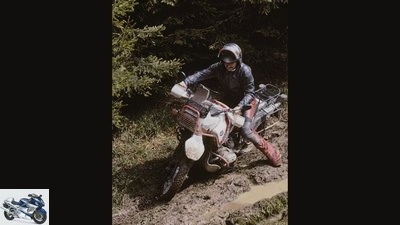
BMW
28/71
1990: R 100 GS Paris-Dakar during driver training.
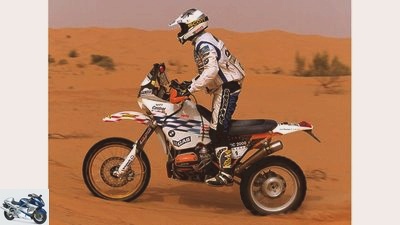
BMW
29/71
1999: Oscar Gallardo at the Tunisia rally on the BMW R 1100 GS / RR.
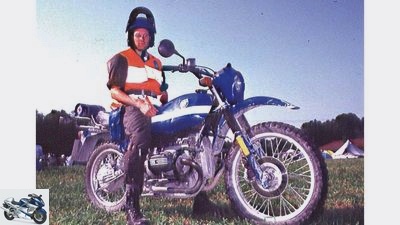
30/71
1990: The R 65 GS is not a bestseller. Here is a machine with an unusual paint job, the 27 hp bike is part of the THW Franken motorcycle squad.
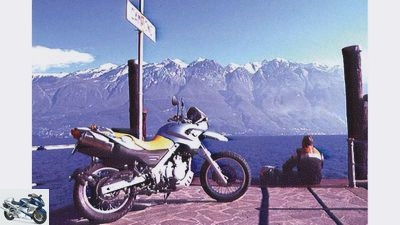
Artist
31/71
2000: With the relocation of production from Italy to Berlin, the single-cylinder Enduro F 650 was finally given the nickname GS, received injection and G-Kat, and its design was based on the R 1150 GS.
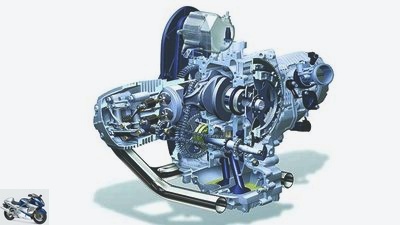
Drawing: BMW
32/71
The completely renovated 1200 engine with balance shaft.
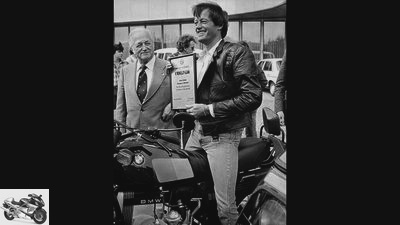
BMW
33/71
1982: Peter Fonda, movie hero through ?? Easy Rider ??, receives the certificate ?? The man who campaigned for freedom on two wheels ?? and becomes an honorary member of the BMW Club Europa e.V.
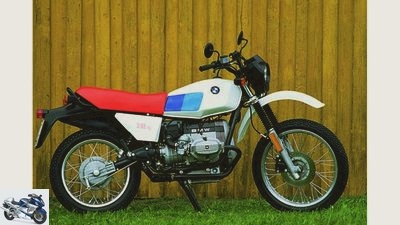
BMW
34/71
The sales success of the R 80 G / S (over 20,000 units) ensured the continued existence of BMW-Motorrad.
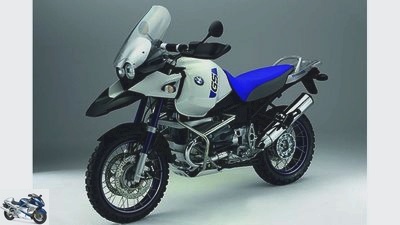
BMW
35/71
2002: To this day, BMW offers the 1150 in addition to the 1200, namely in the adventure trim (e.g. fat tank).
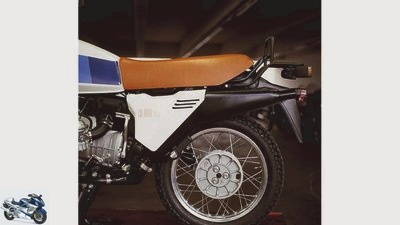
BMW
36/71
Monolever of G / S.
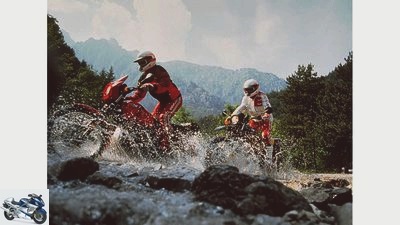
BMW
37/71
R 80 and R 100 GS when leaving together.
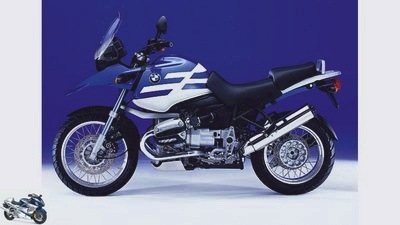
BMW
38/71
R 1150 GS.
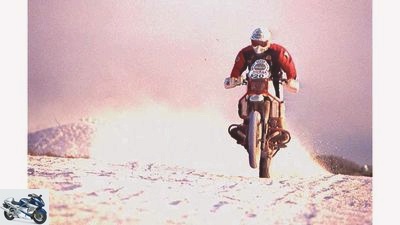
39/71
1992: BMW engineer Jutta Kleinschmidt finishes the Paris-Cape Town Rallye with a broken foot, but as the fastest woman on a near-series R 100 GS
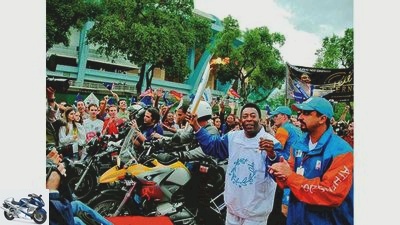
BMW
40/71
2004: TV teams also rely on BMW GS, as here at the Athens Olympics. Next to it a prominent torchbearer: the Brazilian soccer legend Pele.
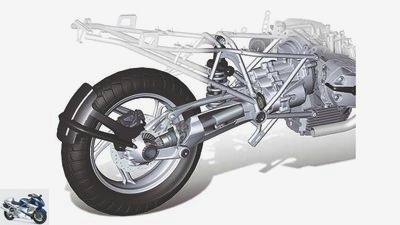
41/71
The double-joint (Paralever) swing arm was already available in 1987 in the second generation of GS, it suppresses annoying load change reactions.

Gutsche
42/71
1975: Rudiger Gutsche, Dolomites rally enthusiast and later G / S project manager, builds an agile BMW enduro with a 19-inch front wheel
and short swing arm.
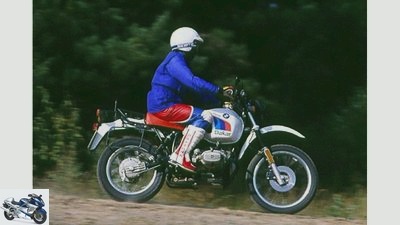
43/71
The lavishly equipped special model won numerous comparative tests.
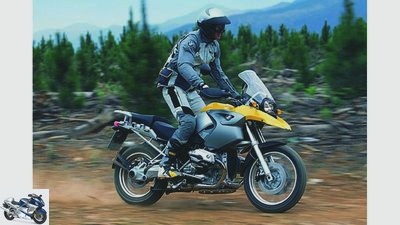
BMW
44/71
In 2004 the 1200 comes onto the market.

BMW
45/71
Here Gaston Rahier (right) and Hubert Auriol after Rahier’s Dakar victory in 1984.
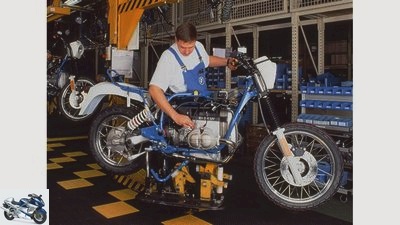
BMW
46/71
1996: Production of the Basic in the BMW motorcycle factory in Berlin.
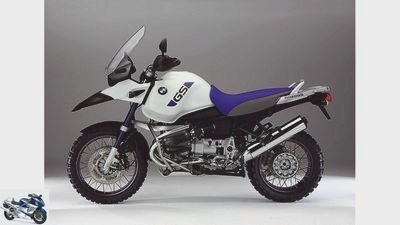
BMW
47/71
2005: To mark the 25th anniversary of the GS, BMW launched a special series of the R 1150 GS Adventure. In the coming year, the big Adventure will also get the new 1200 boxer.
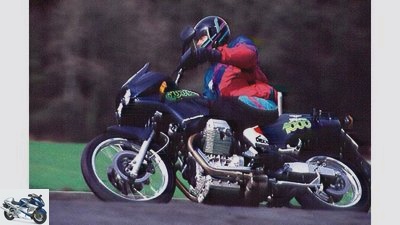
duke
48/71
1992: Actually a similar concept to the GS, but hardly anyone wants the Moto Guzzi Quota despite studded tires, 1000 V2 and cardan drive. Too bulky, too heavy, too little dynamic.
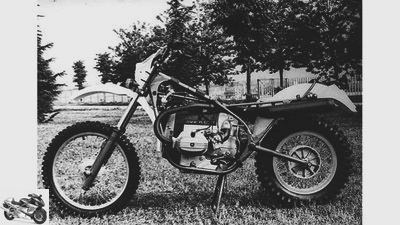
Laverda
49/71
1977: Laverda produced some prototypes with a light special frame, Marzocchi telescopic fork and central spring strut on behalf of BMW, here a test vehicle with an R 60/7 engine.
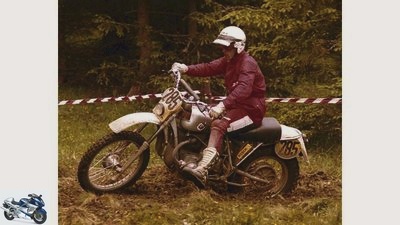
BMW
50/71
From the test department to the start: Laszlo Peres and its prototype with an 800 engine based on the R 65.
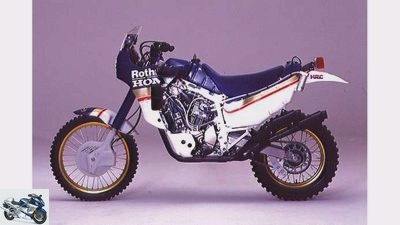
Honda
51/71
1986: Big hit from Japan. Honda announces a replica of the Paris-Dakar winning machines NXR 750 owned by Cyril Neveu and Gilles Lalay. However, it does not come, instead the less sporty Africa Twin only comes in 1988.
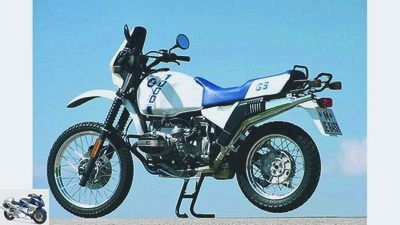
52/71
That also means more power and a more pleasing design.
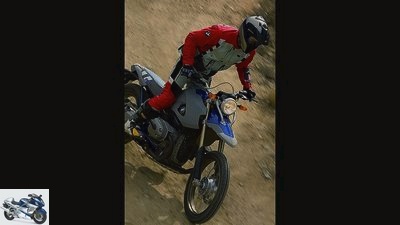
BMW
53/71
Brand new: Exclusive athlete HP2.
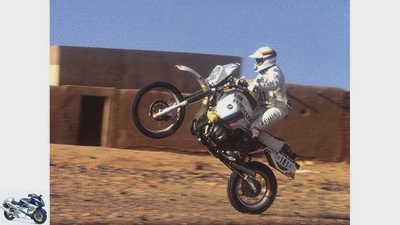
BMW
54/71
Rahier on the road at the Paris-Dakar.
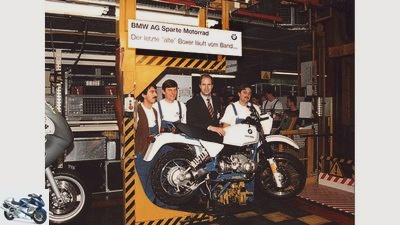
BMW
55/71
1996: The last R 80 GS rolls off the production line in Spandau, an R 80 GS Basic. Remaining stocks are still being offered in South Africa from 1997 onwards? as
R 80 GS Kalahari with 35 liter tank.
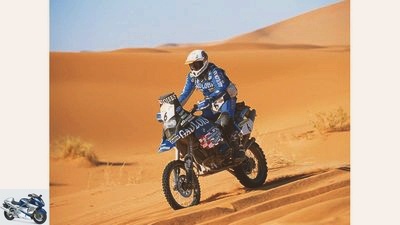
BMW
56/71
John Deacon on the R 900 RR at the 2001 Dakar.

57/71
The duckbill design is a shock to many GS fans.
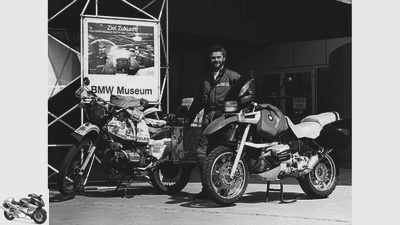
BMW
58/71
1981: Helge Pedersen, photographer and globetrotter, starts on his R 80 G / S ?? Olga ?? to orbit the earth. After 350,000 kilometers in ten years, the Norwegian will later put his bike in a museum.
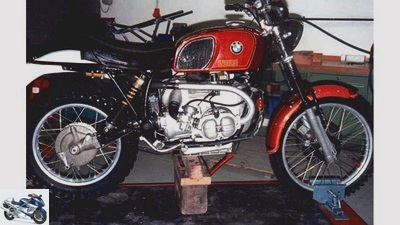
Gutsche
59/71
Test vehicle: the "Red Devil", already with single-sided swing arm and strut moved to the right.

BMW
60/71
But many R 100 GS were susceptible to the cardan shaft and gearbox.
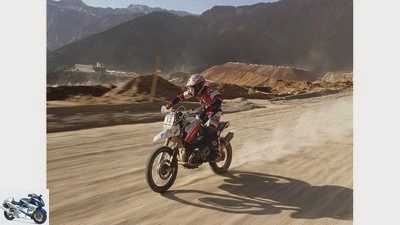
BMW
61/71
One of the first races: Jimmy Lewis at the Erzberg Rodeo in 2005.
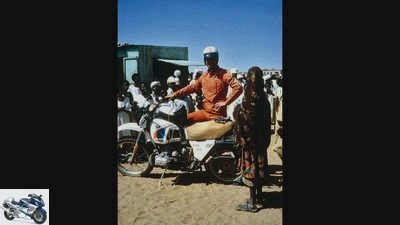
BMW
62/71
R 80 G / S at the Paris-Dakar.
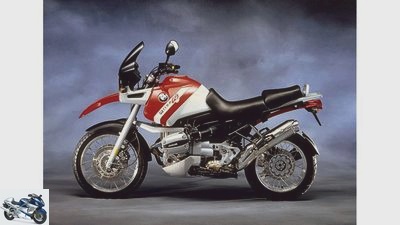
BMW
63/71
R 1100 GS.
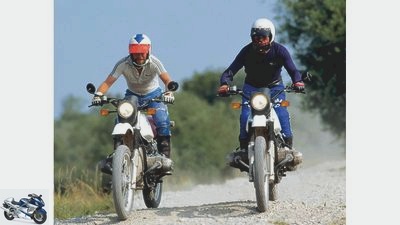
BMW
64/71
This photo documents contemporary fashion when it comes to wearing protective glasses.
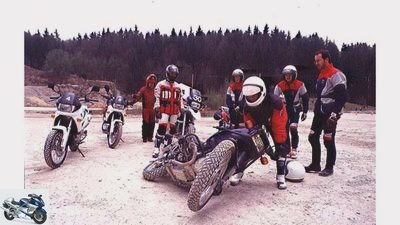
Enzmann
65/71
1995: Practice area for offside drifters. The BMW Enduro Park Hechlingen opens in the middle of the Altmuhltal Nature Park ?? with steep driveways, a water passage and a desert sand passage .

duke
66/71
1983: G / S receives Japanese competition, Honda introduces the XLV 750 R. A 61 hp cardan enduro with a weight of 220 kilograms and a massive frame made of square profiles.
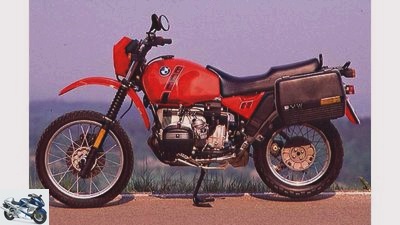
duke
67/71
1987: G / S becomes GS. Paralever and Marzocchi telescopic fork on the second GS generation.
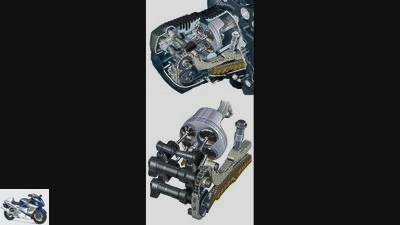
68/71
The new design with four radially arranged valves and two overhead camshafts enables higher speeds, more efficient cam profiles and more power.
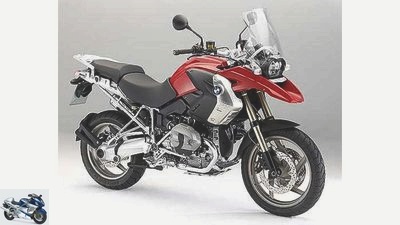
69/71
New for 2010: BMW R 1200 GS. From the 2010 model year, the GS and GS Adventure will receive the new double-cam boxer. Data: two-cylinder four-stroke boxer engine, bore / stroke 101/73 mm, 1170 cm³, 81 kW (110 PS) at 7750 / min, 120 Nm at 6000 / min.
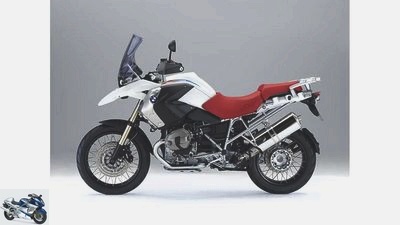
BMW
70/71
Anniversary model 2010: The special model of the BMW R 1200 GS for the thirtieth anniversary of the GS series offers its crew no red carpet, but a red bench. The cross-spoke wheels allow tubeless tires to be fitted and are more elastic than cast wheels. Good for driving on rough slopes, as the author once discovered in view of a GS cast wheel that was bent without falling.
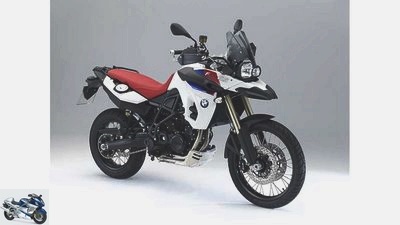
BMW
71/71
Anniversary F 800 GS: The BMW F 800 GS, which is a little closer to the original than the R 1200 GS, is also available in the special edition for an extra charge of 550 euros. If you look closely at the aluminum tub to protect the engine, you will understand part of the additional price, the rest goes to the hand guards, the paintwork and the windshield.
Spotlight: BMW R 80 G / S
30 years of the BMW R 80 G / S
MOTORRAD had invited to the all-terrain boxer’s milestone birthday – and everyone came. Designers and inventors, a few companions from the competition, the big sister R 1200 GS and, for the serenade with a souvenir photo, the brass band – originally Bavarian.
Many anniversary motorcycles share the same fate: they no longer exist. Retired by the marketing department, victim of the ruthless market economy or overtaken by a new trend. The original R 80 G / S is also history. However, a story with an almost magical ending. To experience the legends and myths about the creation of the BMW R 80 G / S first hand, MOTORRAD invited those people who, with their enthusiasm and passion, had put a completely new type of motorcycle on wheels: the travel enduro.
S.ou are scattered today, so racing legend Helmut Dahne reactivated the old contacts for MOTORRAD. The man from Munich, who was involved in the development of the Metzeler Enduro 1 profile specially designed for the GS, actually brought together all of the remaining specs from the BMW development department. Not even today, since everyone is of the sprightly retirement age, one should expect the gentlemen to travel to the Jagerwirt in the idyllic Aufhofen south of Munich in a stylish 5-series BMW. These men are carved from a very special, one might say hardwood. Hardened by the tough school of off-road sports and infested with the sheer passion for motorcycles, they casually balanced their private and carefully kept G / S on the main stand. "Samma olle do?"- Yes we are all there.
Buy complete article
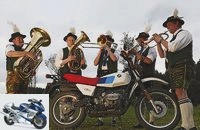
Spotlight: BMW R 80 G / S
30 years of the BMW R 80 G / S
Africa Twin 650 / RD03 and Yamaha’s Super Tenere 750 in a white / yellow / blue rally look. To round off 30 years of development history, the Ducati Multistrada 1200 marches alongside the current BMW R 1200 GS and demonstrates with over 150 hp, fat 17-inch wheels and a whole sack, pardon a whole black box full of electronic hocus-pocus, where the development has gone. A greater distance from the original idea of the R 80 G / S is currently hard to imagine. Switching to the "Enduro mode" little.
In stark contrast to the modern Italian interpretation of the big enduro theme, the G / S models of the former development team stand in line. Equipped for travel and everyday use or as a radical 75 HP lightweight construction by Laszlo Peres, a dream for every boxer freak. She won’t let go of it, the G-dash-S. Does anyone else have a new GS 1200 in the garage? Entering silence. "The hom of oim z’vui. Z’vui Gwicht, z’vui technique – and z’hoch san’s a, the Neien." Did not understand? No. Then again in written German. "They have too much of everything. Too much weight, too much technology and they are too tall, the newcomers", That is the unanimous tenor of the veteran BMW squad. You still see a G / S as a motorcycle for off-road use. Handy, agile, with coarse studs, fine characteristics and ready acceleration from all speeds.
Jahn
If it can no longer be an original G / S, then a late basic is also permitted. The main thing is to be as light and simple as possible.
Weak market and risky management decisions – in 1979 BMW motorcycle production was on the verge of collapse. Fortunately, the development department managed to take advantage of an important trend of the time. The history of the BMW R 80 G / S is linked to that of an entire class of motorcycle. Animated by the desert rallies that have become fashionable, motorcycle adventurers packed huge tanks on spindly off-road machines, bunkered vital water supplies in fat canisters and thus circumnavigated the whole world. Other globetrotters rely on the quality and performance of tried and tested road machines and tried to compensate for short suspension travel and lack of ground clearance with massive engine protection. As a result, Japanese mass-produced motorcycles, completely unsuitable for off-road use, left wide and deep tracks in the desert sand.
Out of these twists and turns, a motorcycle was created in Munich that was supposed to combine full performance from 800 cubic centimeters of displacement and acceptable off-road capability. Developed by a handful of BMW men who converted their experiences with the factory off-road machines from the late 1970s into a series product. After all, the boxers got involved in the enduro class over 750 cubic centimeters created in 1978. BMW chassis developer Laszlo Peres already set an example in the first year with the runner-up title. His self-built motorcycle, unpainted and weighed dry, weighed just 124 kilograms. The Allgau enduro specialist Richard Schalber closed the sack in 1979 and brought the championship title to Munich. You’d think that BMW couldn’t have staged a better debut for the R 80 G / S. But the G / S project was actually on shaky ground. Strangely enough, that was due to the engine.
In the mid-1970s, the number of votes calling the bumper boxer increased "old-fashioned" criticized and wanted to abolish. He almost took the G / S concept with him to the grave. And so a G / S forerunner, internal name, came to an end in the basement of the testing department "Red Devils", his shadowy existence. Only when the shine of the headlights focused on the off-road, soberly made one-off and the design department added an appealingly painted prototype, the passionate practitioners were able to convince the BMW management team of the G / S concept."The G / S actually came into being in secret, because the management at the time did not know what to do with off-road sports and enduro bikes," Head of Development Richard Heydenreich remembers the difficult time in Munich. To get to the point: there were neither construction plans nor a marketing strategy for the R 80 G / S. All preliminary stages were the handcrafted tinkering of a handful of enthusiastic motorcycle freaks. Your hour came when the motorcycle division was in dire straits.
Jahn
Staggered from front to back: the G / S, the competitor models inspired by it and the descendants from 2010.
Under pressure from Japanese competition and the growing influence of car manufacturers at BMW, prototypes of a new boxer model, known as the K1, and two horizontal in-line engines with three and four cylinders were created by 1979. Richard Heydenreich had to decide about these developments when he started his job as head of development. He stopped all three. "At 255 kilograms, the K1 was much too heavy without noticeably more power than a / 7.
The in-line engines had little in common with the later ones, they were short-stroke engines with a very large bore. That would have been possible with the three-cylinder, but it made the four-cylinder much too long. We had to start all over and urgently needed an attractive model to bridge the gap, otherwise the motorcycle division would not have survived. So we took what we had and got the G / S ready for series production in just one and three quarters of a year."
The G / S was allowed to weigh a maximum of 200 kilograms, the high art of omission was in demand. In the hunt for every superfluous gram, the development team was given a treasure that had been hidden in the drawer until then: the revolutionary single-sided swing arm. BMW designer Hans Albrecht had come up with it and presented his boss with a finished construction drawing. It was so convincing that samples were made immediately. Test director Ekkehard Rapelius still remembers the coincidence with a smile. "The two-sided swing arm left no space for the intended, raised two-in-one silencer, while the asymmetrical single-sided swing arm freed up the left rear area, was two kilograms lighter and moreover 30 percent stiffer."By the way, the single-sided swing arm made changing wheels child’s play. Of course, the transition to the new technology did not go off without any problems. The three wheel bolts loosened on the first prototypes. Richard Heydenreich’s troops only got this phenomenon under control when they switched from the conical wheel bolts common in cars to threaded bolts with nuts and separate, inlaid conical rings. In all of the following Boxer series, four nuts clamped the wheel onto the hub. Better safe than sorry.
30 years of BMW G / S part 2
Jahn
The G / S always tempts you to ride on small roads through the countryside.
There were already indications that a single brake disc in the 21-inch front wheel could be too radical a lightweight construction. So it said in MOTORRAD 17/1980: "A lot of hand strength, little braking effect." Which by and large exhausted the criticism of the brand new G / S. There was no lack of superlatives when the BMW R 80 G / S was presented in MOTORRAD. The talk was of the largest, fastest and most expensive enduro. No wonder, since back then only the spearhead of Japanese cult enduros was digging through the deserts of this earth, the 33 hp single-cylinder Yamaha XT 500. Introduced in 1976 and immediately loved as an adventure motorcycle, the XT 500 was for 5098 Mark plus additional costs compared to the 8920 mark expensive BMW R 80 G / S the purest bargain and with 155 kilograms also a real flyweight. Aside from half-hearted scrambler models with raised exhaust systems and antler-hard handlebars, neither the European competitors nor the Japanese had a two-cylinder off-road machine on their plan at the time.
G / S set this stone rolling. Impressed by the engine, chassis and handling, the MOTORRAD test drivers in 1980 came to a clear and unambiguous conclusion: "The R 80 G / S is the best street BMW that MOTORRAD has ever driven." A message that got everywhere. The Munich-based company had proven that the balancing act between off-road suitability and road quality can actually be achieved.
Honda hit the first counterattack in 1983. The XLV 750 R was brightly colored in the spectacular factory colors and modeled after the Crossers with a fire-red V2 engine. Cardan drive, single disc brake, 19.5-liter tank, 61 hp, 220 kilograms – it goes without saying that the stylish Honda aimed exactly at the concept of the Munich inventor. Nevertheless, she achieved only moderate sales success. Which is a shame despite all the sympathy for the G / S, because as we know today, the XLV 750 R had a lot more potential than Honda wanted to develop.
Jahn
The lamp mask is one of the few details that the designers contributed to the G / S. The technicians designed most of the work themselves.
Not only the big Japanese motorcycle manufacturers were inspired by the Munich idea, the small European manufacturers also tried their hand at the ingeniously simple concept. The resounding success was also denied them.
After the XLV, Honda needed another four years before the robust, staid Transalp XLV 600 could compete with the G / S for the first time. However, this only really succeeded in the Africa Twin XRV 650 from 1988. Classy styled, with a perfect synthesis of off-road capabilities and road qualities, the XRV 650 opened the battle for the favor of wind and sun-tanned adventurers.
Yamaha entered the competition in 1989, packed a 69 hp twin in the tubular steel chassis and raised the bar a little higher in terms of performance. The growing popularity of the BMW GS, from 1987 without a line, could not be affected by any. Incidentally, the R 100 GS, which is equipped with a drive-neutral Paralever swing arm, was created in complete secrecy.
Ignored by the enduro purists among BMW drivers because of an overdose of technology and weight, the R 1100 GS from 1994, the first with a four-valve boxer, found its way to global success. Subscribed to the title of the best-selling motorcycle in Germany for years, the constantly evolving GS boxers gradually cast a spell over the sporty Italians, the patriotic French and Spaniards, and even the English. On its thirtieth birthday, the R 1200 GS became the world’s best-selling motorcycle. The developers at G / S would not have dared to dream that. But they probably already had an inkling of the special quality of their creation. Richard Heydenreich: "The R 80 G / S was the only future-oriented new design from BMW that everyone, but really every employee in the motorcycle department was completely enthusiastic about. There has never been such unanimous approval for any project before or after."
The competition of the BMW R 80 G / S




8th photos
Images: Spotlight: BMW R 80 G / S
To home page
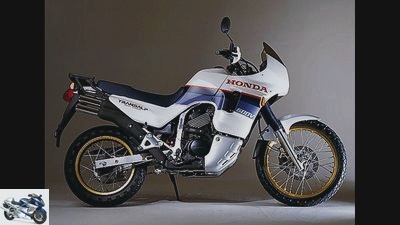
archive
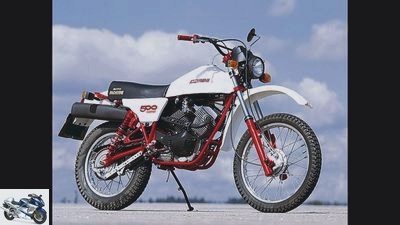
archive
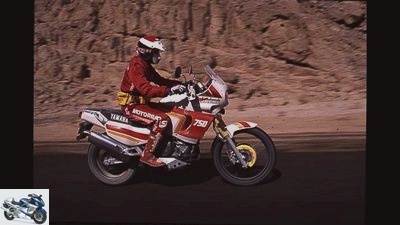
archive
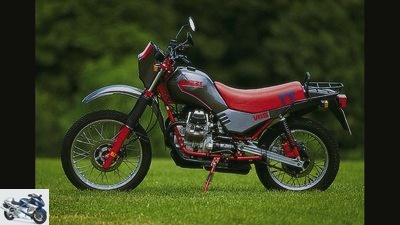
archive
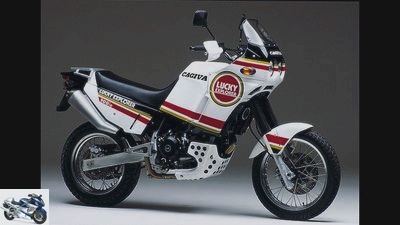
archive
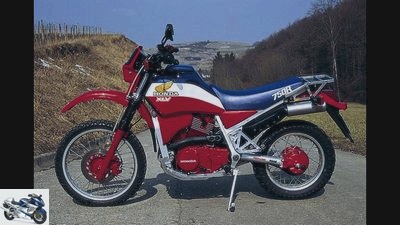
archive
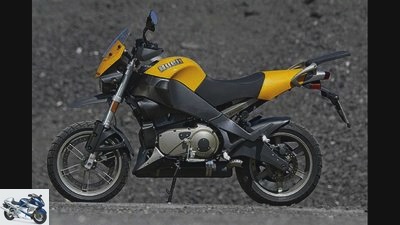
archive
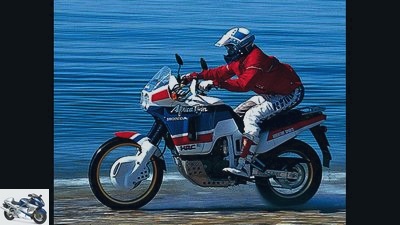
archive
Moto Morini Camel 500, the Italians put on the new off-road fun. Honda’s advance with the XLV 750 R from 1983 went in a completely different direction: away from pure off-road operation towards the easy-care travel enduro. In 1984/1985, Moto-Guzzi from Italy registered with the V35 TT in the BMW segment. With disc brakes, cardan drive and adequate pillion suitability, the 90-degree V2 engine with its 35 hp simply lacked power.
In 1987 Honda started the second attempt with the XLV 600 Transalp. It was supposed to be the only competing model of the R 80 G / S, the basic concept of which has remained unchanged in the Honda salesrooms to this day. Not only the name, but also the water-cooled V2 engine was retained, but has been modernized since 2008 with injection, 680 cm3 displacement and four-valve instead of three-valve cylinder head.
In 1988 the legendary Africa Twin XLR 650 followed, which over the years established itself as the toughest competitor for the BMW R 80 G / S and its successor models. As a robust and almost indestructible travel enduro all over the world, the question arises why Honda did not build on this unique image with an adequate successor.
In 1989, Yamaha tried to enter the travel enduro market with the Super Tenere XTZ 750. The two-cylinder five-valve engine with almost 70 hp was the most powerful drive with fine manners at the time. Small weaknesses in equipment and chassis, which Yamaha unfortunately did not correct in the following model years, deprived the XTZ 750 of its great success.
In 1993 Triumph presented the Tiger 900, with one cylinder more than the competition, but also with a weight of 260 kilograms. A good idea, but unfortunately still flawed. So this attack on the BMW camp had no decisive effect.
For years, Suzuki and Kawasaki did not take up the issue of travel enduro seriously. The small Kawasaki KLE 500 from 1991 was an attempt, nothing more. Suzuki only occupied the segment with products to be taken seriously with the V-Strom 650 and 1000, Kawasaki with the structurally identical KLV models, in which, however, off-road suitability was sacrificed for travel comfort. With the result that the V-Strom 650 was chosen by MOTORRAD as the Alpine Master in 2005 and 2006.
Jahn
Alexander Mayer
Was development master at BMW Motorrad from 1968 to 2001. Takes care of valuable G / S prototypes that he couldn’t or didn’t want to bring to the meeting with MOTORRAD. A catch-up date is due.
Jahn
Laszlo Peres
Famous off-road athlete and formerly a BMW technician doing suspension tests. Speaks wonderful engineering Bavarian; For him, a “Heisl” is not a toilet, but a motor or gearbox.
Jahn
Ekkehard Rapelius
Headed the motorcycle trial 30 years ago. Teasing colleagues claim that he was skeptical of the single-sided swing right from the start. That’s why he had to praise its advantages in an interview with MOTORRAD in 1980?
Jahn
Louis Schneider
At the age of 80, still an enthusiastic participant in the Dolomites rally. Was responsible for accessories and police equipment at BMW and contributed a lot to tap into this important source of revenue.
Jahn
Helmut Dahne
When G / S was established, he developed and tested tires at Metzeler, including the Metzeler Enduro 1. Holds the all-time lap record on the Nurburgring-Nordschleife. He especially loves two motorcycles: the Honda RC 30 and the limited-series R 80 GS Basic.
Jahn
Rudiger Gutsche
Under his leadership, the “built” prototype of the G / S became the constructed template for large-scale production. Traveling in the desert is his passion; He was in the Sahara 24 times, of course also with the G / S.
Jahn
Richard Heydenreich
At that time head of motorcycle development. Still looks like a good old-school boss. Detached, but always with his people. Today deals with the design and production of fine bicycle components.
Related articles
-
On the move: 30 years of GS models from BMW
Frank Herzog 71 photos BMW 1/71 1985: Little Gaston Rahier fights his way through the desert again with his huge HPN boxer and can successfully defend…
-
Manufacturer 23 photos Manufacturer 1/23 2012: R 1200 GS Everything new: The air / liquid cooling is done by a glycol-water mixture, the previously…
-
20 years of Triumph Speed Triple
fact 22nd photos Breutel 1/22 Stuart Wood, 50, Head of Model Planning and Electronics, has been with Triumph for 27 years and is involved in the…
-
Technology 20 years of progress in motorcycle construction: Honda Fireblade – old against new
fact 14th photos fact 1/14 At the end of 1991 Honda presented the first Fireblade and shook the athlete Olympus permanently. We compare the Fireblade SC…
-
25 years of Ducati Monster anniversary
Ducati 28 photos Ducati 1/28 2018: Ducati Monster 821. Ducati 2/28 Ducati Monster concept sketch by Miguel Galuzzi from 1992. Ducati 3/28 1993: Ducati…
-
PS anniversary The best sport bikes from 40 years
archive 25th photos archive 1/25 Honda CB 750 Four The Honda CB 750 Four is the mother of all four-cylinder in-line engines and caused quite a stir when…
-
30 years of Suzuki GSX-R history
Suzuki / fact 36 photos Suzuki 1/36 30 years lie between the newest and the oldest model. Suzuki 2/36 Unfortunately, the rain in Lausitz made driving the…
-
Final: 25 years of the Kawasaki GPZ 900 R
Artist Final: 25 years of the Kawasaki GPZ 900 R Fire under the bum It opened a new era: strong, fast, stable. The GPZ 900 R, Kawasaki’s first ninja with…
-
Harley-Davidson 75 Years of Knucklehead
Photos: Harley-Davidson Finale: Harley-Davidson anniversary 75 years of Knucklehead cruisers The ancestor of all modern Harley-Davidson motorcycles was…
-
Report: 25 years of Kawasaki Ninja
archive 16 photos Kawasaki 1/16 1984: Kawasaki GPz900R Ninja The evolution of the Kawaski from 25 years ago to the present day. Kawasaki 2/16 2003:…